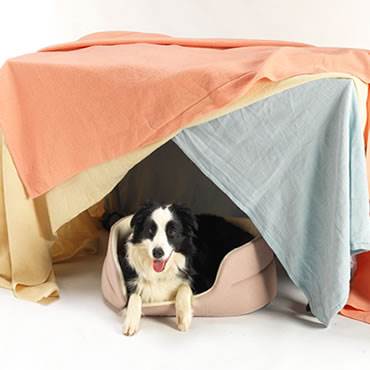Eight million pets fear fireworks
01 November 2017
Vet charity provides #FireworksReady action plan for owners
Leading vet charity, PDSA, is urging owners to take action to help tackle their pets’ fireworks phobias this year. Shockingly, the PDSA Animal Wellbeing (PAW) Report found that 39% of dog and cat owners report that their pets are afraid of fireworks, meaning around eight million pets* are affected by fireworks phobias.
PDSA Vet, Rebecca Ashman, explained: “Sadly, two in every five cats and dogs suffer distress due to fireworks, and their response can range from mild to very extreme. Many shake and tremble, are unable to settle, soil in the house and destroy furniture. They can even cause themselves physical injury if they panic, try to escape or run away.
“While we can’t prevent fireworks from happening, owners can take steps to reduce their pets’ anxiety. Puppy and kitten owners also have an opportunity to prevent this phobia by including fireworks noises as part of their desensitisation and socialisation regime. Getting them used to fireworks noises can stop these fears from taking hold in later life.”
To help combat the problem, PDSA has published a new ‘Fireworks Ready’ action plan to help owners manage their pets’ anxiety. Thanks to support from players of the People’s Postcode Lottery, the charity’s vets have prepared detailed guidance for pet owners, including special playlists (available on Spotify) to help mask the sound of fireworks, which include tracks such as Cat People by David Bowie, Bark at the Moon by Ozzy Osbourne, and Jai Ho! featuring the Pussycat Dolls.
There is also a downloadable checklist to help owners prepare for firework display nights. All are available from www.pdsa.org.uk/fireworksready
PDSA’s top ten tips to get pets #FireworksReady
- Build a den for your pet somewhere where they feel safe. For dogs, this may be behind the sofa or under a table. Cover it with blankets and line with pillows or cushions to help absorb the noise. Cats often feel safest when high up, so a safely secured, covered cat bed on top of a wardrobe or shelf may be their preferred option. Don’t force pets to use it, but a healthy treat or praise when they do helps to build positive associations and encourages them to use it.
- Use a sound CD with young pets, to help familiarise them with the noises of fireworks. A few months ahead is best, but even a few weeks of preparation helps. Play on the lowest volume in another room at first, and very gradually increase the volume and duration over a period of weeks. Rewarding your pet when they show calm behaviours is key, and if they get anxious, stop immediately and go back a step.
- Ensure cats and dogs are microchipped and their registered details are up to date. (This is a legal requirement for dogs anyway). So that if they run off in panic, they can be quickly reunited with their owner.
- Make a note of the dates of local fireworks displays and put a reminder in your phone so you can make sure you are prepared. Stay home and have plenty of toys and distractions to hand.
- Bring rabbit and guinea pig hutches indoors on fireworks evenings. A car-free garage or shed is ideal. Provide plenty of extra bedding hay and cover the hutch with thick blankets to minimise the noise, but be sure not to obstruct air flow. For hamsters, gerbils and other small indoor pets, move cages away from windows and again make sure they have plenty of bedding so they can hide if they’re frightened.
- Walk dogs early on fireworks nights and make sure your cats are indoors before dark, and the cat flap is closed. Close all doors, windows and curtains fully, well before displays start.
- Play music to disguise the noises. Something with a repetitive beat is ideal, or anything that your pet finds calming or relaxing (suggested playlists are available on PDSA’s website).
- Try calming pheromones. These are available as diffusers or sprays that release scents which are undetectable to humans, but have a calming, reassuring effect on our pets.
- Look out for signs of anxiety which include shaking, cowering, hiding, refusing to eat, toileting in the house, pacing and panting or trying to run away. If your pet shows any of these signs then remain calm yourself, but provide comfort to your pet as you normally would if they need you. If they hide in their den don’t try to coax them out. Let them stay where they feel safest.
- If your pet gets very afraid of fireworks this season, visit your vet to get advice on tackling the problem long term. They may recommend medication or advise on how to get specialist behavioural advice.
PDSA vet Rebecca continues: “If your pet is afraid of fireworks we’d always recommend speaking to your vet. They can discuss possible treatments, which may include medication, or referral to an accredited pet behaviourist. The good news is that with patience, it is possible to help your pet combat these phobias. But it does take time, so if your pet suffers badly this bonfire night, start now to prepare them for the New Year celebrations.”
For more advice, and to download the Fireworks Ready checklist, visit www.pdsa.org.uk/fireworksready

#FireworksReady
Read our vets' advice about how to help your pet cope with the fear of fireworks.
Pets and fireworks